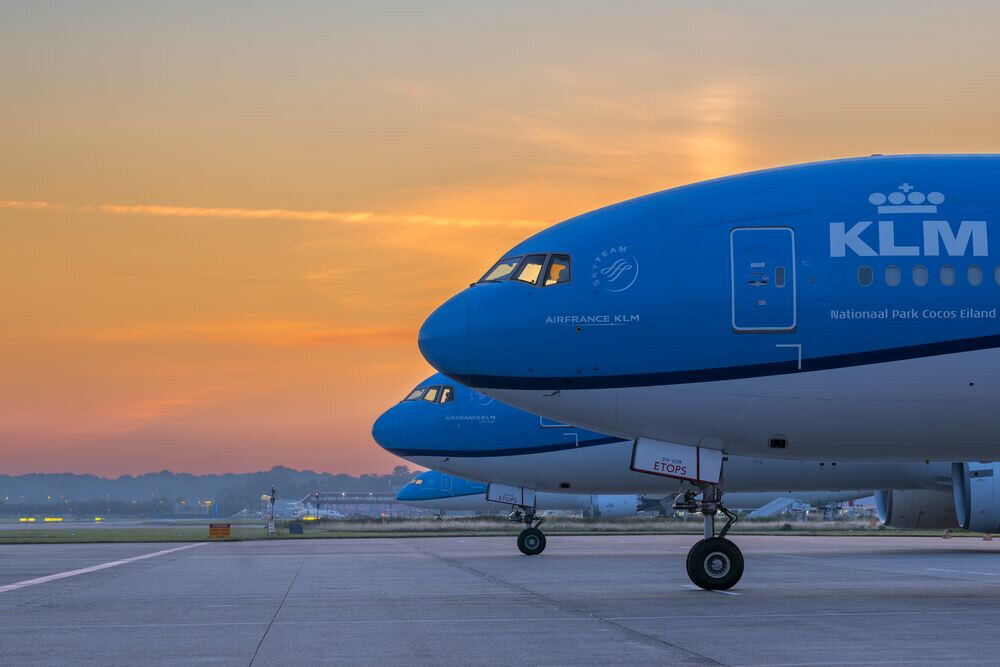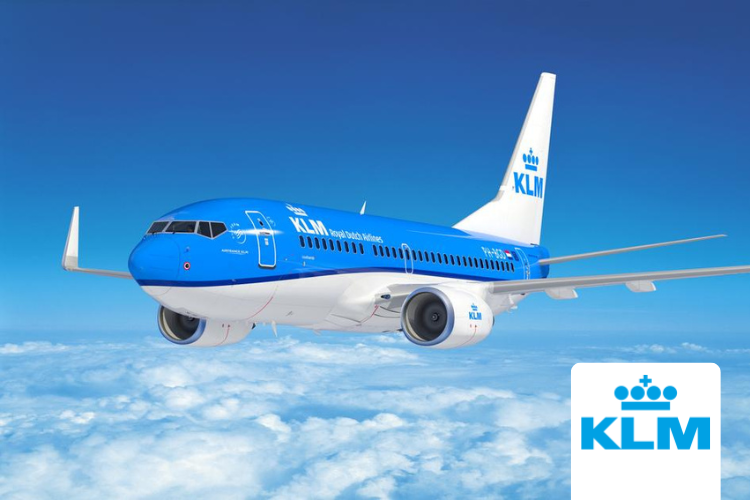Customer Data Platform Case Study
Growth Hacking For Customer-Centricity with KLM

+25%
Increase in revenue from 'mail my search' customers vs. control group
+800%
Above average value per sent email
+170%
Increase in click-through rate
+5%
Conversion rate from paid media & reduction of media waste

by Michiel Blonk
VP Pricing & Revenue Management Europe KLM Royal Dutch Airlines
A NEW BREED OF MARKETING
Data and creativity; technology and emotional intelligence; innovation and authenticity. Marketing is evolving into a paradox with a hybrid of dots to connect businesses and customers. This fact already permeates the travel landscape on every level. Perhaps for marketers who have followed hunches instead of data trails over the past twenty years, this different way of doing, measuring, working and thinking may come as a surprise.
But if we look back fifty years, this convergence of ideas and business practices adds up. Local stores have been balancing economical sense and people focus to build their livelihoods since time untold. From treating customers to something special based on their loyalty or value, to making product recommendations depending on behavior and probability to purchase, this holistic approach should only have been scaled with the arrival of multiple technologies and touchpoints.
At KLM, we’ve been looking back to our heritage to drive our airline forward, using customer service as a differentiator. And we’ve done this by adopting a collaborative, adaptable, test-and-learn approach to marketing, empowered by smart tools.
KLM's Vision for Travel Marketing with Relay42
The making of the modern marketing team
This paradox in marketing goes beyond binaries, though. Balancing business value and meaningful human interaction isn’t a zero-sum game. This is why my entry into the world of marketing at KLM (from a background in Revenue Management) meant learning by doing, then seeing and approaching things differently.
With so many channels at our disposal through which we serve tickets to our customers, we knew we needed to go beyond increasing ad dosage as flight departure-date loomed closer. Instead, we needed to carefully engineer the frequency and sequencing of each relevant message, in the context that most made sense.
This meant building a core multidisciplinary team covering the entire spectrum — from math-minded statisticians and channel specialists, to wordsmiths with a storytelling sixth sense, and those sitting somewhere in between.
TECHNOLOGY AS AN ENABLER
As the world gets smaller and marketing disciplines converge, the digital landscape expands. We need the flexibility to latch onto opportunities, try out new modes of communication with our customers, and grow in ways we never expected.
We need to keep people connected — both our passengers, and those piloting their marketing journeys — and for that we need flexible data-driven technology to stitch together and orchestrate our experiments. Technology that enables us to get started quickly, and to add actions to our analyses based on the footprints travelers leave across the digital and offline world.
As engineers of growth, we are nothing if not tenacious when it comes to hurdling walls — and overcoming challenges. In the following pages, I will share what we did and how you can find similar success by doing and thinking differently in marketing.
Our secret formula: Serve acts, not ads

LAYING THE FOUNDATION FOR THE FUTURE - A CONNECTED BUSINESS ARCHITECTURE
The following three KLM journeys require a smart marketing hub to seamlessly connect all customer channels and internal business systems — present and future. We chose the Relay42 platform, which addressed our prerequisites for unifying technology.
1. Flexible fit, plug-and-play capabilities
Our platform needed to be a seamless fit with all of our varied and existing best-in-class systems and channels. This meant complete compatibility by design to remain disruptive in our marketing without disrupting our IT framework.
2. Faultless accuracy in knowing our customers
To sustain one-to-one conversations at scale, our platform must identify people — and their data trails — across the KLM marketing landscape regardless of context, to keep our communications 100% relevant.
3. Actionable data in real time to automate dialogue
It follows that we need to add actions to our existing analytics. Our platform must orchestrate data in real-life moments rather than in bi-weekly batch data exports. This makes our journeys frictionless and keeps our customers happy.
4. Future-proof, for zero channel lock-in
In hacking our future responsibly, we want to be able to try new ways of reaching our customers without a complete system overhaul or having to wait for development. This way, we can see what works while it still matters, to not only remain ahead of the game, but to give ourselves the room to change the rules completely.
Translating technical details into practical reality
As a hands-on team ready to learn, accelerate and improve fast, how did this technology work in practice at KLM?
We're going to show you how to create simple cross-channel decisioning to optimize media spend. Next, we'll explain how to control the sequencing and frequency of messages via automated triggers to deliver effective one-to-one communication. Finally, we'll talk about how we increased customer engagement by measuring how customers interact differently with us in response to our omnichannel experiments.
THE MARKETING ECOSYSTEM

PART 1 - HOW CAN WE OPTIMIZE OUR MEDIA SPEND?
Using a data management solution for smarter decisioning across paid and owned channels
At KLM, we want to achieve the best of both worlds by delivering incremental business value alongside serving relevant content. We started by using a single customer profile to map movements across biddable media and owned or internal systems and channels, and then created cross-channel rules and logic to alter bidding and targeting per customer, depending on their likelihood to book a flight.

RESULTS

MICRO-JOURNEYS
We can create customer journey rules for bidding logic and apply them across our marketing landscape as a cross channel command center, with the help of the Relay42 platform:
Case A) If a customer converts on one channel or their departure date has passed, stop retargeting across all platforms
Not only are we able to orchestrate bidding across the digital landscape, but vice versa. If a passenger converts offline (e.g. call center), we can stop focusing our resources on serving them messages across every channel. Real-time automation can also be extended to flight dates: if a potential customer has searched for a destination through KLM but their departure date has lapsed, we know our ads and one-to-one messages are irrelevant, so we stop targeting.
We also know they chose another airline, so we can focus on creating a compelling win-back sequence next time they fly.
Case B) Alter bidding resource allocation based on customer value
We use value parameters such as time to departure or search history for higher value destinations to control and shape our bidding strategy. This means we can increase or decrease bidding on channels such as search per individual based on their previous interactions with us and likelihood to book via other channels like our website or email. This includes using our Revenue Management System as a medium to feed Google Search with relevant data. By using the plane fill-rate in combination with customer value, we concentrate our resources on the passengers with higher intent.
For customers? This means less incessant ads and more content at an appropriate frequency, depending on their intent or urgency to book.
Case C) Personalize display and search content to maximize paid conversions
We can also use search behavior and interactions from our own channels to show relevant content across paid media, and vice versa. Say a customer is searching for flights to Spain on our website. If they have clicked through to a promotional offer via an email, we don’t only alter our bid based on key terms or relevant publishers – we alter the content we show, too. By dynamically updating content across display banners and search ads to reflect Spain and pre-fill dates, we significantly increase our relevance, and hence, our conversions via paid channels.
Now, passengers are not only seeing relevant ads at the right time – but ads containing exactly the right content for them.
Part 2 - HOW CAN WE ORCHESTRATE ONE-TO-ONE MARKETING, TO MANY?
Using a marketing platform to trigger messages that make sense by controlling sequencing and frequency
In digital advertising, accuracy and individual relevance are highly beneficial. When marketing via one-to-one channels, accuracy is crucial. Direct communications aren’t just a helpful hint in your periphery, embedded in a public piece of content; these are messages designed just for your customer.
So, what makes sense for them as an individual, and for your business? At KLM we use trigger-based logic to determine the best place (channel) to deliver a sequence of messages (based on which action, and in what volume?) to a specific segment of customers (in what context?). Then consider elements of value and how you can use them to determine what content you serve to each customer, when, and how.
Connected channels:

Case D)
Segment X of KLM customers have all opted in for email communications, have downloaded the KLM app, and have indicated an interest in a flight departing in the coming month. These terms qualify them for a campaign in Relay42 for re-targeting via email and push message.
You'll see how we might orchestrate their journey, along with the logic we might use.

Case E) Innovating for customer convenience with ‘Mail my Search’
When we consider innovation in marketing, we often leap to the need to add something new, purely for the sake of inventiveness or novelty.
So instead of over-analyzing the reasons why a customer sale gets interrupted, we created a flexible and functional shortcut so passengers can browse, consider, compare — pause — then continue their purchase where they left off. We added service, and in doing so, we integrated our mobile and web channels.
CASE RESULT
25% INCREASE IN REVENUE FROM ‘MAIL MY SEARCH’ CUSTOMERS VS. CONTROL GROUP
Imagine a potential customer is about to leave KLM.com, having searched for a destination.
The Relay42 platform triggers a pop-up when the customer’s email is not already in the KLM database.
The customer is emailed their search, which then anchors their progress in the customer journey across devices so they can continue their booking where they left off.
Bonus: this significantly increased the capture of relevant contacts for KLM within the test market.
Tip: balancing structural experiments with broader innovation strategy.
Every experiment we conduct needs to be measurable. That’s why at KLM, we always benchmark our tests against control groups within Relay42, the results of which are then pushed to our chosen analytics platform through a serverto-server connection in real time.
But it’s also important for us to balance these agile, quick-win tests with always-on campaigns that complement our long-term strategy for growth. What broader goals do we want to achieve? How can our accumulative learnings add up to something greater than the sum of their parts?
Regularly reviewing our progress with the bigger picture in mind helps us avoid losing the overview.
PART 3 - HOW CAN WE INCREASE ENGAGEMENT THROUGH HYPERRELEVANT TARGETING?

Using a data management solution to match third party audience data across first party channels, to reach individuals
Again, it’s time to think laterally about how we can better serve our customers. How can we qualify intent and interest to ensure what we offer makes sense to them? Where we identify an overlap between entire third party audiences (a segment of those who are in the market for travel, and individuals who have interacted with KLM before) is where the magic happens in terms of relevant outreach. We can leverage technology with precision identity management capabilities to make a winning combination of purpose and historical behavior into actions, results and reality.
A third-party audience selection of people who are interested in flying to Paris is compared with a segment of existing KLM customers, and an overlap of individuals is identified.
This valuable overlap segment is then used as the basis for a personalized email campaign. The email content is tailored according to their travel intent for Paris and based on their chosen dates.
Here, KLM can serve hyper-personalized outreach based on technical matchmaking and simple, effective logic. By cross-pollinating data between trusted partners and sources across the KLM landscape, this journey can deliver beyond a triple threat in terms of business value and customer service: right message, right person, right time, and right context. This contextual intelligence both creates smarter budget allocation, and a preferred method of contact by an airline the recipient already knows and trusts.

This valuable overlap segment is then used as the basis for a personalized email campaign. The email content is tailored according to their travel intent for Paris and based on their chosen dates.
Here, KLM can serve hyper-personalized outreach based on technical matchmaking and simple, effective logic. By cross-pollinating data between trusted partners and sources across the KLM landscape, this journey can deliver beyond a triple threat in terms of business value and customer service: right message, right person, right time, and right context. This contextual intelligence both creates smarter budget allocation, and a preferred method of contact by an airline the recipient already knows and trusts.
KEY TAKEAWAYS
Part 1
- Start simple with omnichannel marketing, building basic logic into your campaigns which offers both business and customer value.
- This means optimizing paid channels: how can you combine them in journeys with offline or owned channels in a way that makes sense?
- Then consider elements of value and how you can use them to determine what content you serve to each customer, when, and how.
Part 2
- Make every interaction matter more by focusing on the frequency and sequencing of messages across direct channels.
- Start thinking laterally about channel orchestration that makes sense in a real-life conversation, like how the moment and volume of your communications could impact abandonment rates.
- Consider how you can create functional shortcuts for customers through connected channels. Remember: innovation doesn’t need to mean novelty.
Part 3
- Growth means thinking and doing differently, by having the curiosity to turn challenges on their head and make paradoxes happen.
- An example would be to take a broad audience demographic and a specific customer base, and discover the perfect customers in the overlap between the two.
CREATING VALUE WITH INNOVATION
What did we learn along the way?
-
Start simple by using technology as a command center for experimentation.
-
Think in customer footsteps and broader strategy instead of confining yourself to channels first — or limiting yourself with traditional business silos.
-
Organize people to reflect customer journeys. Instead of large groups of specialists working in isolation, re-shape teams for customer-centricity by cross-pollinating people and skill sets, as well as data.
-
Cultivate a test-and-learn environment where trying new things translates into both real business value and quality service delivery.
-
Allow strategies to merge between marketing and customer service, woven together through technology.
I hope you enjoy the journey as much as I have!
Driving Marketing Growth Value for Inspiring Brands

+115% Conversion Rate Uplift on Brand Search
Levi's Strauss & Co.

+25% In revenue via email marketing
KLM Royal Dutch Airlines
.png?width=750&height=500&name=Untitled%20design%20(28).png)
+272.75% Increase in the number of vacancy alerts
Randstad
.png?width=750&height=500&name=Untitled%20design%20(25).png)
+86% Increase in leads
Vattenfall
.png?width=750&height=500&name=Untitled%20design%20(27).png)
+90% Increase in requests for information
Mazda Netherlands
See Relay42 in Action
Experience a first-hand tour of the Relay42 Customer Data Platform with one of our consultants

